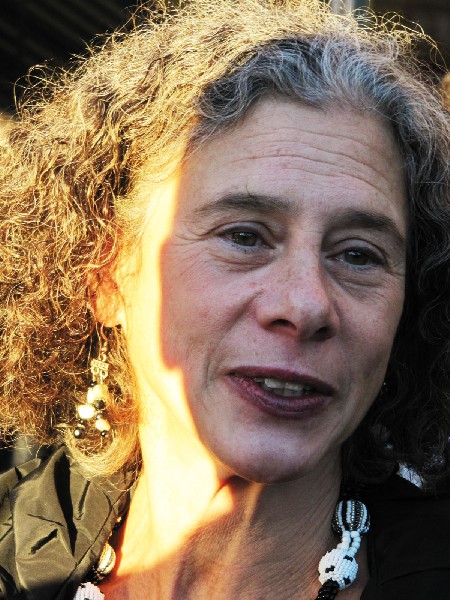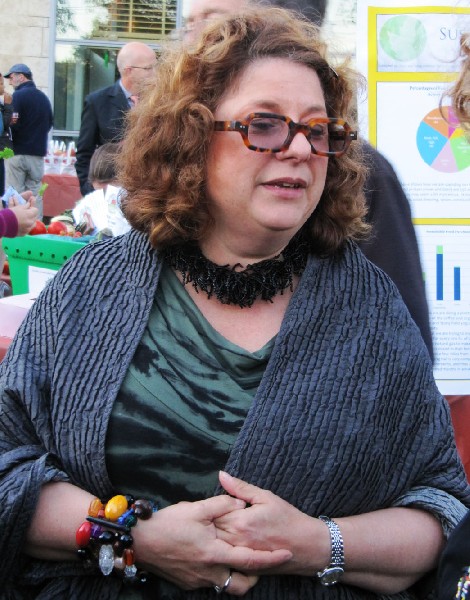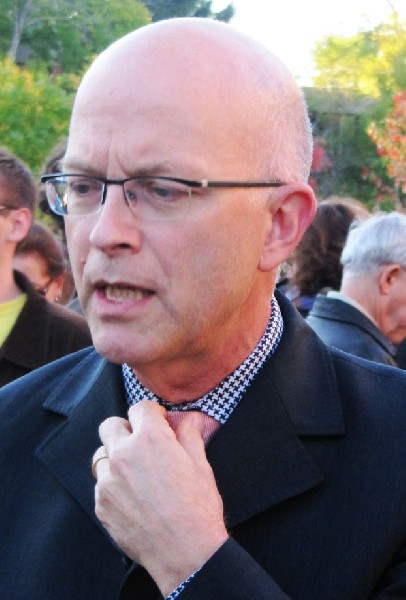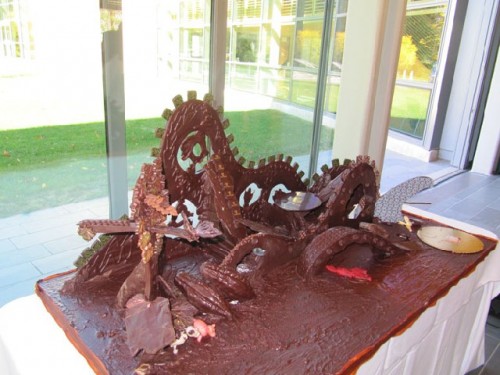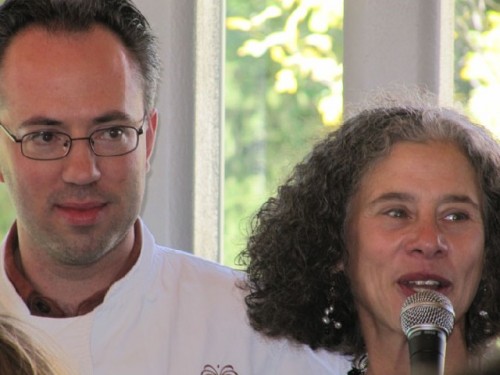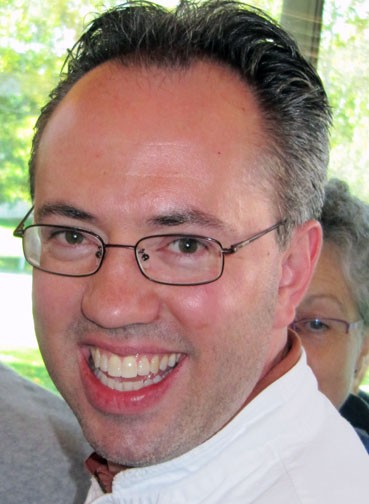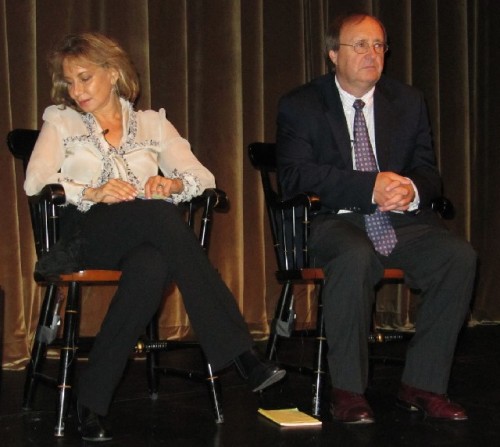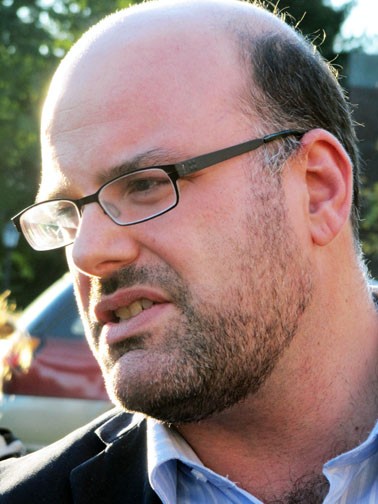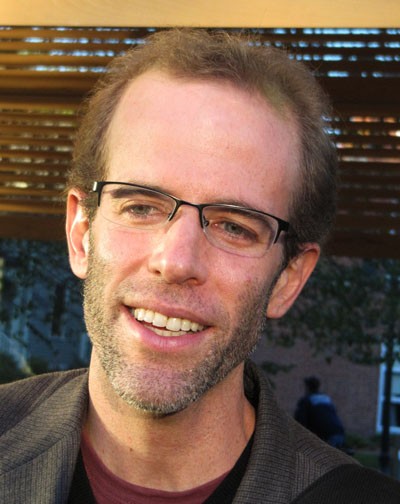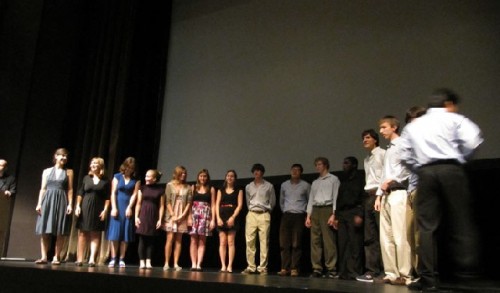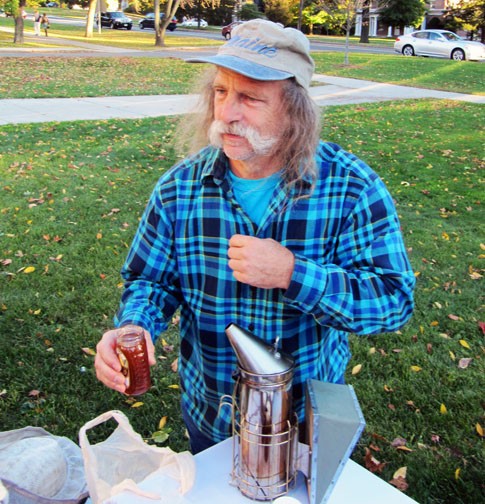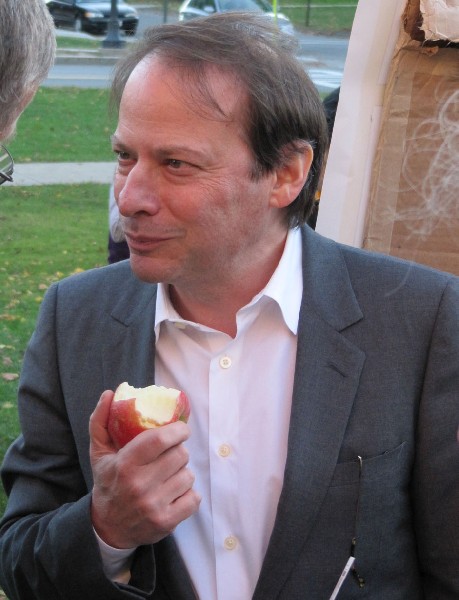Williams College The Place for Taste
Food for Thought
By: Charles Giuliano - Oct 04, 2010
The Place of Taste
A Symposium on Food, Culture and Community
Organized by the Williams College Museum of Art and Gastronomica: The Journal of Food and Culture. In celebration of the journal’s 10th anniversary.
Williams College ’62 Center for Theatre and Dance
October 2, 2010
The day long symposium, organized by Lisa Corrin, the director of the Williams College Museum of Art, and Darra Goldstein, professor of Russian at Williams and founding editor of Gastranomica, conflated a concoction of tasty and intoxicating ingredients from the arts, sciences, philosophy, history, and all matters related to food.
In addition to hearing and thinking about food the audience was invited to destroy and consume a chocolate sculpture signifying, in a most delicious manner, the topography of the Berkshires. This exotic creation, a surrogate for a cake in honor of the tenth anniversary of the publication, was assembled by the chef, Joshua Needleman, of Chocolate Springs in Lenox.
Following opening remarks the first, and by far most entertaining, and profound speaker of the day, was Adam Gopnik, a staff writer for the New Yorker. His forthcoming book The Table Comes First features his food writing for the magazine over the past 25 years.
He started by mulling over a familiar quote from Virgil’s Aeneid “De gustibus non est disputandum” which translates as “There’s no disputing about taste.” With great wit and irony Gopnik argued that nothing is more widely debated than taste.
The dense, intense lecture he delivered to an enchanted audience evoked comparisons to a 32 course meal he had been served recently at a famous restaurant. He commented that humans have the ability to distinguish perhaps six courses. By the end of such a feast, just like his lecture, one would recall little or any detail of its multi valent content. Exactly.
Particularly when it explored the aesthetics of the very different 18th century philosophers Hume and Rousseau. Or evoked images of Marie Antoinette and her ladies as ersatz peasants tending to the royal sheep. He projected an image of the first stone barn on the grounds of Versailles. For such arch pretension it is little wonder she lost her lovely head.
Included in the many courses and sub texts of his lecture were delectable morsels. For example, the inability of his grandfather, a butcher, to understand the expression “You can’t have your cake and eat it too.”
We learned about the austere dining habits of Robespierre who lived in a hotel and ate like a peasant. That starving artists and poets dined on the Left Bank at a restaurant so humble that it could afford to cook only fresh ingredients from the daily market. The bohemians who dined on that cheap, fresh, local produce complained of their fate. He discussed the history of the first commercial restaurants in Paris.
Gopnik observed with irony that this is precisely the mantra of today’s foremost chefs and restaurants. He commented on the diary entries of gourmets from another era who wrote about becoming ill after an evening of fine dining. Just think about all that butter, cream, and refined white sugar. No wonder that gout was an epidemic among aristocrats.
Quite rightly, Bill Yosses, the White House Executive Pastry Chef complained about having to follow Gopnik. He argued the merits of leaving room for desert. It is that aspect of the meal which follows the requirements of nourishment. Dessert is consumed for pleasure and is entirely about taste.
To illustrate his concept of nourishment and taste he described a colleague in the White House who has had a McDonald’s Big Mac sitting on his desk for the past six months. Yosses chuckled about revealing secrets from the White House kitchens. He reported, with alarm, that the burger, while slowly dehydrating, has not changed in color or texture. It is so completely artificial and lacking in nourishment that it has no mold and attracts no flies, worms or rodents. Just imagine what it is doing to those who consume them in quantity.
Shortly after Obama took office Yosses and other White House chefs met with the First Lady. She wanted to set an example for her family and the nation by serving healthy food. A part of that was the creation of a sustainable garden which is shared with school children from D.C. Yosses discussed being involved with that educational project. Many of the children who visit the garden have no idea where food comes from. They get to see and sample food harvested from the garden.
Following a lunch break there was the gleeful destruction of Chef Needelman’s chocolate sculpture. There was a feeding frenzy but more than enough for all.
The afternoon sessions began with a panel On the Dimensions of Taste. It was moderated by Mitchell David, the Vice President of the James Beard Foundation. The panelists included Carolyn Korsmeyer, Professor of Philosophy at the University of Buffalo, SUNY, John E. Finn, Professor of Government at Wesleyan University, and Deborah Rotshchild, Curator Emerita at the Williams College Museum of Art.
The lively discussion ranged from philosophy and theories of aesthetics, matters of taste in the fine arts, to regulation and governance of food. Finn discussed the legal and legislative aspects of food but also holds certification as a trained chef. He railed against the trends toward dictating what diners may eat in some high end restaurant. He spoke of this as Food Fascism. It evoked a round of applause.
Similarly, David railed against trends and innovations among some high ranking restaurants. After a decade and more of innovation he finds much of what is presented as not particularly appetizing. He described just not liking the food served during a recent 42 course meal. He related that to what Gopkin had said about a similar experience.
Between sessions we got to chat with folks behind us. What we all wanted to know is what such a meal might cost? It seems that a top ranked New York restaurant charges about $500 per person for the food, extra for wine, which takes it through the roof. But the top Japanese restaurant in New York starts at $1,000 per person.
That’s not food it’s obscene. We start getting nervous when the check for a couple comes to $75. I have stopped ordering wine by the glass when it is just the two of us. Why pay $8 to $10 for a glass of wine? That averages the restaurant’s cost for the bottle with a pour of four to five glasses. At about 400 % that’s a whopping profit for restaurants. And there is no way of knowing how many days the bottle has been open. By not having that glass of wine, Astrid doesn’t drink, we opt for an appetizer or dessert.
The dinner at Mezze, following the symposium, was priced at $100 per person. Well, after all, it’s in Williamstown.
My friend from Boston, who dates, tells me that to dine, anywhere, without drinks or wine, starts at $100. Makes me glad we’re married. Who can afford to be a bachelor? Rather, I prefer to put the money into a nicely developing wine cellar. Stocking up on French 2005s and 2007s now up to about five cases resting in the cool basement. I’m eagerly waiting for the release of the 2009s which are said to be the vintage of the century. Don’t know if I’ll live to drink them. Maybe I’ll leave them to my pal Bob with whom I enjoy sharing a fine bottle.
Korsmeyer expanded on Hume and Rousseau whom Gopnik had discussed. It was refreshing when Rothschild, an art historian, took another tack. With a disclaimer that she might appear to be reactionary she argued for the now unfashionable notion of connoisseurship and the primacy of the object. Looking at the work of art has largely been replaced by theories about its deconstructed content and intentionality. She lamented a generation of artists and critics who lack the vocabulary for actually looking long and hard at a work of art.
Sight is but one of the senses used in the aesthetics of taste. It seems from a scientific point of view our physical understanding of everything from the range of sound, color, flavor, smell and touch compares poorly with other species. Dogs, it seems, have more precise noses. Our decline in that sense came from when we started to stand erect getting away from sniffing the ground to find food. Perhaps the decline of the astuteness of our senses occured when we evolved beyond the stage as hunters and gatherers. There is a huge difference between hurling a spear at a mastadon and pushing a cart through a super market.
As David commented “I was trained to believe that there are four primary tastes: Sweet, sour, salty and bitter. We now believe there are many more categories like the taste of licorice for example.”
By watching shows like Hell’s Kitchen and its spinoffs we know that an essential skill of a potential chef is the ability to identify different foods and flavors through blind fold tests. This leads to the techniques of blending ingredients and balancing flavors. A great chef must have a refined palate and this entails constantly tasting the food which is served.
Part of the development of the avant-garde in dining is found in ways to release more of the flavor of food through technology. Like fast freezing. It is intriguing to learn about these developments but you need access and a New Yorker expense account to actually dine in world class restaurants in Copenhagen, Provence, and Tokyo. Or Vegas.
Given limited financial resources there is masochism in spending a day devoted to the discussion of such exotic and expensive dining. But there is much to be derived, at a personal, household level from the food revolutions of the past decades.
The session on Cultural Perceptions of Taste, intended to be a dialogue between the artist, Pepon Osorio, currently exhibiting at WCMA, and Williams art history professor, Ed Epping, was improvised when Osorio cancelled because of a family emergency. The panel that pitched in was game but not very focused.
To clear the palate between afternoon sessions there was an interlude of music provided by the Williams Chamber Choir directed by Brad Wells.
The anchor leg of the day was deftly handled by the truly inspiring insights of the chef Dan Barber of Blue Hill in New York. He also operates Blue Hill at Stone Barns in Westchester County. Again, Gopnik has extolled the pleasures of visiting the rural version of the restaurant where one may see the livestock and produce that is raised and grown on site.
Barber offered a grim view of the future when the food industry will no longer be able to produce affordable food based on cheap energy and an abundance of water. He noted that when oil soared to over a hundred dollars a barrel it caused the demise of the nation’s second largest producer of chickens. Feed and transportation became too costly to make a profit.
He noted that the oil crisis caused a spike in the price for farm land in Vermont. When it becomes too costly to ship food cross country from California and Florida it stimulates the movement of local farming.
The notion of fresh strawberries in January just may be obsolete in the future. The trend toward fresh and locally grown sustainable food is more than just a foodie fad. It is also mandated by social, political and economic forces. He takes a dim view that genetically altered seed and more efficient irrigation will save vast parts of the planet including Sub Sahara Africa.
Today I purchased end of the season, locally grown tomatoes. They are so wonderful. I just refuse to buy tomatoes in the winter. It’s just not worth it. Or corn that is not picked that morning from a local farm. Much of the produce we purchase during the winter just looks like food. I grew up on canned peas and corn. It seemed like a miracle when Birds Eye sold frozen food. That ended the tradition of fresh peas and salmon on the Fourth of July. We have just lost the rationale of seasons. But Barber implies that there may be global economic factors that will revise our thinking and dining habits.
With passion he talked about producing more flavorful food. Like the sugar content in carrots. The ones available in super markets have little sugar, and hence no real flavor. Compared to the ones he has been growing for Blue Hill which are, when tested “off the chart.”
He also argued for the delicious sea bass, at $20 a pound, which he flies in from a fish farm in the South of Spain. Unlike most fish farms which pollute the environment the operation in Spain is so well designed that it actually improves and filters waste water. The eco system is so healthy that the fish are given no artificial feed or antibiotics. It also attracts a vast population of birds which feed on about 20% of the fish. This is viewed as a signifier of the success and health of the system.
Even factoring the costs and environmental impact of importing fresh fish from Spain Barber described this as supporting the concept of “locally grown.” It is a response to the collapse of Atlantic fisheries. He discussed the recovery of fisheries in Maine because of stringent regulation in the past decade. This was contrasted with the disaster in Chesapeake Bay.
During a period of questions there was discussion of reintroducing over fished pogies and other “trash fish” used for processed feed. This would help to cleanse the Bay and improve the food chain. These fish apparently cleanse four times their weight in water per hour.
Exiting the theatre we enjoyed the final presentation of the day A Taste of Place. There was a farmer’s market featuring honey, maple syrup, apples, squash, and preserves. The locally produced honey we purchased will continue to remind us of a wonderful and flavorful symposium.


